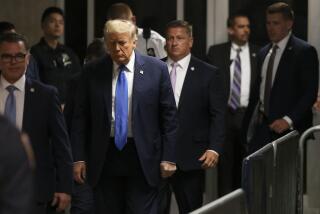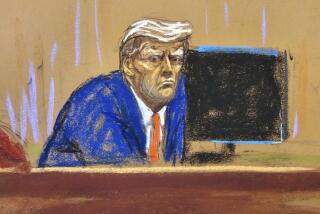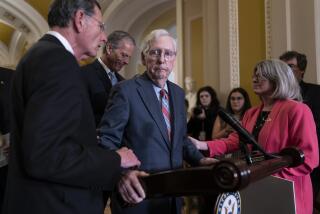Senate Decides to Live With TV : Votes 78-21 for Cameras After Six-Week Trial
- Share via
WASHINGTON — Apparently liking what it had seen of itself during a six-week trial in which its debates were televised, the Senate Tuesday voted overwhelmingly to allow cameras to remain in its chamber permanently.
With its 78-21 vote, the Senate was “building an electronic bridge to the American people,” Senate Majority Leader Bob Dole (R-Kan.) said.
Use of television in the Senate picked up significantly more support than it had in February, when the Senate approved the six-week test on a 67-21 vote.
“It’s here to stay and we can live with it,” said Sen. Robert T. Stafford (R-Vt.), one of those who reversed his initial opposition.
But Sen. Jake Garn (R-Utah), an early supporter of television, said that the camera had transformed senators into “performers.” As he left the brightly lit Senate chamber after casting his vote against television, he said it was “a sad day for the Senate.”
In the end, most senators seemed to believe that the television and radio broadcasts had made little difference in the manner in which they did business. Moreover, many said that the changes wrought by television were largely for the better.
“You walk in (the Senate chamber) and suddenly you’re on stage,” Sen. William S. Cohen (R-Me.) said. “There’s a tendency to be on your best behavior. . . . The debate’s a bit better and people are generally better prepared.”
‘The Intrusive Eye’
“It’s gone over better than ‘most anybody could have suspected,” conceded Sen. J. Bennett Johnston (D-La.), a long-time opponent who voted against continued television. Johnston said he still had reservations about what he once called “the intrusive eye of the camera.”
In its initial weeks, television showed self-conscious senators sporting telegenic red ties and positioning themselves so that the camera caught their best sides.
“You could almost tell who was going to speak that day” from the way senators were dressed, Cohen said. “But that’s pretty much gone,” he added.
Helping to push the Senate into the electronic era was competition from the House, which began to televise its proceedings in 1979. “They got a little tired of us grabbing the news,” said House Speaker Thomas P. (Tip) O’Neill Jr. (D-Mass.).
House Watched by More
The House, whose sessions are broadcast gavel-to-gavel into 25.5 million homes on C-SPAN, the Cable Satellite Public Affairs Network, still attracts more viewers. C-SPAN II, featuring live Senate proceedings, reaches only 8.2 million homes because cable systems resisted the idea of putting Congress on two channels.
However, Senate staffs quickly learned to maximize television’s political value by alerting television stations in their home states when their senators will be speaking on important issues. The local stations can pick up the debate by cable or satellite and rebroadcast segments on nightly newscasts.
As a result, the number of “special orders”--daily time allotted to senators who want to speak about any subject they wish--has more than doubled, according to a study released last week by the Congressional Research Service.
Otherwise, the camera apparently made little difference. The Senate still idles away a large part of a typical day, for example, in “quorum calls,” which are parliamentary devices that use up time as senators argue over what to do next. Rather than show viewers a near-empty chamber during these periods, Senate rules require that the screen be blanked out.
Seeks to Curb Abuses
To help guard against abuse, the bill allowing broadcast of Senate debate contains a stipulation against using television for “political or commercial purposes”--a provision that critics said was too vague.
Both California senators, Democrat Alan Cranston and Republican Pete Wilson, voted in favor of continuing television coverage. Both also had supported the initial test.
The trial period showed that the ornate Senate Chamber has its drawbacks as a television studio. One of the first orders of business, Dole said, will be repainting its khaki-colored walls, which make senators “look like they’re standing in pea soup.”
More to Read
Get the L.A. Times Politics newsletter
Deeply reported insights into legislation, politics and policy from Sacramento, Washington and beyond. In your inbox three times per week.
You may occasionally receive promotional content from the Los Angeles Times.










